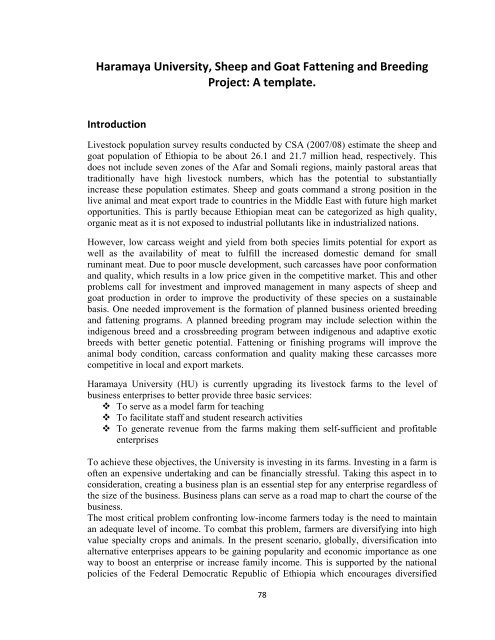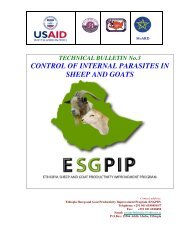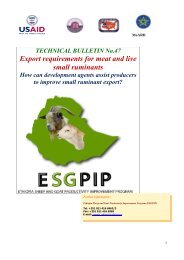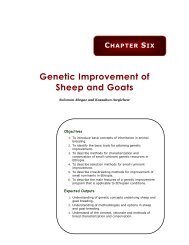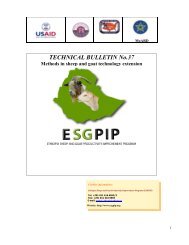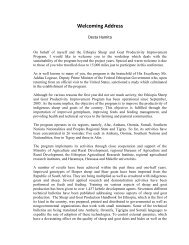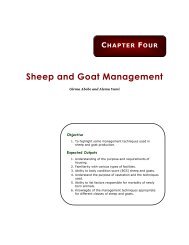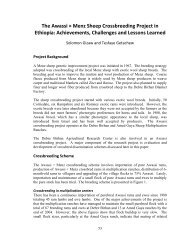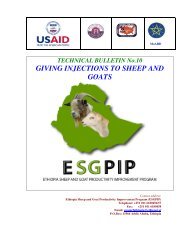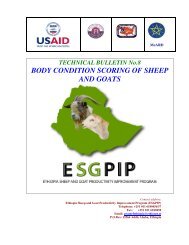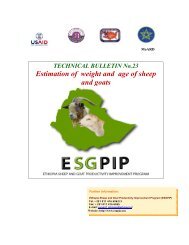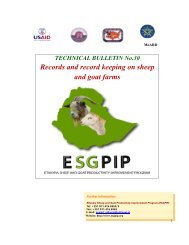Haramaya University, Sheep and Goat Fattening and ... - esgpip
Haramaya University, Sheep and Goat Fattening and ... - esgpip
Haramaya University, Sheep and Goat Fattening and ... - esgpip
You also want an ePaper? Increase the reach of your titles
YUMPU automatically turns print PDFs into web optimized ePapers that Google loves.
<strong>Haramaya</strong> <strong>University</strong>, <strong>Sheep</strong> <strong>and</strong> <strong>Goat</strong> <strong>Fattening</strong> <strong>and</strong> Breeding<br />
Project: A template.<br />
Introduction<br />
Livestock population survey results conducted by CSA (2007/08) estimate the sheep <strong>and</strong><br />
goat population of Ethiopia to be about 26.1 <strong>and</strong> 21.7 million head, respectively. This<br />
does not include seven zones of the Afar <strong>and</strong> Somali regions, mainly pastoral areas that<br />
traditionally have high livestock numbers, which has the potential to substantially<br />
increase these population estimates. <strong>Sheep</strong> <strong>and</strong> goats comm<strong>and</strong> a strong position in the<br />
live animal <strong>and</strong> meat export trade to countries in the Middle East with future high market<br />
opportunities. This is partly because Ethiopian meat can be categorized as high quality,<br />
organic meat as it is not exposed to industrial pollutants like in industrialized nations.<br />
However, low carcass weight <strong>and</strong> yield from both species limits potential for export as<br />
well as the availability of meat to fulfill the increased domestic dem<strong>and</strong> for small<br />
ruminant meat. Due to poor muscle development, such carcasses have poor conformation<br />
<strong>and</strong> quality, which results in a low price given in the competitive market. This <strong>and</strong> other<br />
problems call for investment <strong>and</strong> improved management in many aspects of sheep <strong>and</strong><br />
goat production in order to improve the productivity of these species on a sustainable<br />
basis. One needed improvement is the formation of planned business oriented breeding<br />
<strong>and</strong> fattening programs. A planned breeding program may include selection within the<br />
indigenous breed <strong>and</strong> a crossbreeding program between indigenous <strong>and</strong> adaptive exotic<br />
breeds with better genetic potential. <strong>Fattening</strong> or finishing programs will improve the<br />
animal body condition, carcass conformation <strong>and</strong> quality making these carcasses more<br />
competitive in local <strong>and</strong> export markets.<br />
<strong>Haramaya</strong> <strong>University</strong> (HU) is currently upgrading its livestock farms to the level of<br />
business enterprises to better provide three basic services:<br />
To serve as a model farm for teaching<br />
To facilitate staff <strong>and</strong> student research activities<br />
To generate revenue from the farms making them self-sufficient <strong>and</strong> profitable<br />
enterprises<br />
To achieve these objectives, the <strong>University</strong> is investing in its farms. Investing in a farm is<br />
often an expensive undertaking <strong>and</strong> can be financially stressful. Taking this aspect in to<br />
consideration, creating a business plan is an essential step for any enterprise regardless of<br />
the size of the business. Business plans can serve as a road map to chart the course of the<br />
business.<br />
The most critical problem confronting low-income farmers today is the need to maintain<br />
an adequate level of income. To combat this problem, farmers are diversifying into high<br />
value specialty crops <strong>and</strong> animals. In the present scenario, globally, diversification into<br />
alternative enterprises appears to be gaining popularity <strong>and</strong> economic importance as one<br />
way to boost an enterprise or increase family income. This is supported by the national<br />
policies of the Federal Democratic Republic of Ethiopia which encourages diversified<br />
78
activities. Diversified enterprises can be profitably integrated into small scale operations<br />
benefiting both rural <strong>and</strong> urban groups of entrepreneurs. <strong>Haramaya</strong> <strong>University</strong> can benefit<br />
through boosting its revenue generation <strong>and</strong> improving teaching <strong>and</strong> research quality<br />
through sheep <strong>and</strong> goat breeding <strong>and</strong> fattening projects. Moreover, the surrounding<br />
community will benefit from the breeding <strong>and</strong> fattening enterprises in various ways.<br />
The current business plan considered <strong>and</strong> addressed the following in order to improve<br />
<strong>and</strong> transform the sheep <strong>and</strong> goat business into a profitable self supporting enterprise:<br />
• Lesson: This project will help us to learn a lesson from earlier setbacks. In the<br />
process of preparing this project, we learned how to negate factors that caused<br />
earlier setbacks. The project, therefore, helped us improve <strong>and</strong> generate positive<br />
<strong>and</strong> sustainable results.<br />
• Pragmatic approach: In the past, these farms had a number of problems related<br />
to finance <strong>and</strong> management. Therefore, with an optimistic approach we hope this<br />
project will benefit from the introduction of innovative management, economic,<br />
financial <strong>and</strong> advanced scientific measures to overcome those drawbacks <strong>and</strong> to<br />
make this venture a sustainable operation.<br />
• Unreliable financial support: In the past, the sheep <strong>and</strong> goat farms funding was<br />
mainly dependant on short term projects. The financial structure of the farms<br />
fluctuated with availability of project funds. This financial instability prevented<br />
the smooth operation of the sheep <strong>and</strong> goat farms. The current project plan will<br />
enhance the introduction of innovative management, economic <strong>and</strong> financial<br />
measures to overcome those drawbacks <strong>and</strong> to produce sustainable business plan.<br />
• Mission objective: Resource optimization <strong>and</strong> maximization to achieve<br />
sustainable development goals.<br />
• Goal/Vision:<br />
To embark on a sustainable plan to achieve a reliable source of organic small<br />
ruminant meat for the local, regional, national <strong>and</strong> international market<br />
To be leader in the supply of organic small ruminant meat. This vision is<br />
strongly supported by the conditions presently prevailing in Ethiopia, i.e., a<br />
total agrarian based economy with low levels of release of industrial effluents<br />
<strong>and</strong> other pollutants which are either directly or indirectly affecting meat<br />
quality <strong>and</strong> its impact on health of the consumer.<br />
• Historical reasons: Historical evidence shows that Ethiopia was the “Bread<br />
Bowl” for the Roman Empire in ancient days. As in the past, Ethiopia can also be<br />
a good quality meat exporter to show that history repeats.<br />
• Linkage effect of the project: There is a possibility of linking this project with<br />
the community in order to improve livelihood. The linkage effect of the current<br />
project could be reflected in the following areas.<br />
Nutrition <strong>and</strong> health: To generate a source of nutritional <strong>and</strong> health<br />
improvement, especially for local population.<br />
Socioeconomic aspect: Poverty alleviation for disadvantaged farmers<br />
especially women.<br />
Sustainability aspect: Income generation, capacity building <strong>and</strong> human<br />
resource development.<br />
79
Innovation: Small ruminants breeding <strong>and</strong> fattening can be linked with<br />
microfinance.<br />
<strong>Haramaya</strong> <strong>University</strong> <strong>Goat</strong> <strong>and</strong> <strong>Sheep</strong> Enterprise history <strong>and</strong> ownership<br />
The <strong>Haramaya</strong> <strong>University</strong> Small Ruminant Farm consists of the <strong>Sheep</strong> <strong>and</strong> <strong>Goat</strong> Farms<br />
both of which are situated on the main campus. The <strong>Sheep</strong> Farm was established way at<br />
the opening of the Animal Science Department in the 1960s to support small ruminant<br />
teaching <strong>and</strong> research activities. The <strong>Goat</strong> Farm was established in 1988 through an<br />
agreement between FARM-Africa <strong>and</strong> the Ministry of Agriculture for a dairy goat<br />
development project. The primary objective of the <strong>Goat</strong> Farm was to serve as a breeding<br />
center. The center produced crossbred goats (Anglo-Nubian×Somali) that were<br />
distributed to the community, particularly women, to increase income generation through<br />
improved milk production.<br />
The infrastructure <strong>and</strong> management of the <strong>Sheep</strong> Farm has been remained poor <strong>and</strong> has<br />
served as a teaching <strong>and</strong> research center since its establishment. The <strong>Goat</strong> Farm has been<br />
better equipped <strong>and</strong> managed. Unlike the <strong>Sheep</strong> Farm, the <strong>Goat</strong> Farm has impacted the<br />
community during the last 20 years through distribution of crossbred goats to female<br />
farmers. Further, different research activities have been undertaken by <strong>Haramaya</strong><br />
<strong>University</strong> <strong>and</strong> other university’s students using different goat breed crosses.<br />
However, the capacity <strong>and</strong> service of the <strong>Goat</strong> Farm has diminished, particularly after the<br />
FARM-Africa project ended. The decline was attributed to financial constraints <strong>and</strong> poor<br />
management practices. These have resulted in decreased numbers of animals, particularly<br />
purebred exotic animals. The new business plan aims to stimulate <strong>and</strong> transform sheep<br />
<strong>and</strong> goat production into a sustainable self-supporting enterprise that generates revenue<br />
<strong>and</strong> support quality research <strong>and</strong> teaching.<br />
General objective<br />
The main objective of the project is to evaluate the economic potential of the<br />
existing <strong>Sheep</strong> <strong>and</strong> <strong>Goat</strong> Farms by estimating the investment requirements,<br />
production costs <strong>and</strong> returns for the purchase <strong>and</strong> sale of high quality sheep <strong>and</strong><br />
goat for fattening <strong>and</strong> for the breeding program of both sheep <strong>and</strong> goat farms for a<br />
period of five years.<br />
To provide baseline information <strong>and</strong> guidelines for future project development of<br />
crossbred goats <strong>and</strong> sheep so as to provide an economic incentive for enterprising<br />
entrepreneurs in the rural <strong>and</strong> urban centers.<br />
To develop a project that will serve as a template to attract more investors towards<br />
similar businesses.<br />
80
Specific objectives<br />
To make the goat <strong>and</strong> sheep project economically viable by regularly undertaking<br />
fattening of purchased <strong>and</strong> farm-born male offspring having superior growth <strong>and</strong><br />
carcass characteristics.<br />
To generate herds of crossbred female <strong>and</strong> male kids for marketing <strong>and</strong><br />
distribution to smallholder producers <strong>and</strong> private firms on a profitable basis<br />
To provide modern research <strong>and</strong> developmental facilities for the scientists <strong>and</strong><br />
students of <strong>Haramaya</strong> <strong>University</strong>.<br />
To make the goat <strong>and</strong> sheep project profitable by introducing effective<br />
management practices.<br />
To harness the special skills of the staff related to animal sciences, veterinary<br />
science, management <strong>and</strong> social sciences for the development of both farms on a<br />
sustainable basis.<br />
To make <strong>Haramaya</strong> <strong>University</strong> a business hub with a vision <strong>and</strong> mission to<br />
establish a Centre of Excellence in <strong>Sheep</strong> <strong>and</strong> <strong>Goat</strong> Research that will breed <strong>and</strong><br />
distribute animals of high genetic potential to enterprising groups from rural <strong>and</strong><br />
urban centers for rearing <strong>and</strong> consequently play the role of a buy-back facilitator.<br />
To promote an ultra-modern, state-of- the-art abattoir, meat <strong>and</strong> meat product<br />
production center meeting international st<strong>and</strong>ards for domestic consumption <strong>and</strong><br />
for international export.<br />
To identify <strong>and</strong> market other related product lines such as milk, manure, skin <strong>and</strong><br />
other by-products from small ruminant production.<br />
To develop a model goat <strong>and</strong> sheep enterprise project which will attract more<br />
investors in sheep <strong>and</strong> goat breeding <strong>and</strong> fattening businesses to fulfill the large<br />
domestic <strong>and</strong> international dem<strong>and</strong> for sheep <strong>and</strong> goat meat.<br />
To contribute towards the process of diversification of economic activities, that is<br />
aligned with government policies, through this project <strong>and</strong> similar project which<br />
use this as a model.<br />
81
Rationale for establishing a small ruminant breeding <strong>and</strong> fattening<br />
enterprise<br />
To enhance the income generation potential of smallholder farmers.<br />
To optimize the efficient use of pastoral <strong>and</strong> agro-pastoral l<strong>and</strong>s for small<br />
ruminant production.<br />
Create employment opportunities in farmer households by introducing community<br />
level adoption schemes based on community impact workshops.<br />
Link women farmers, small ruminants <strong>and</strong> microfinance in an innovative scheme<br />
by providing women entrepreneurs the opportunity to rear small ruminants in<br />
open grassl<strong>and</strong>s.<br />
82
Introduce systems of cooperatives to target village economic constraints of small<br />
ruminant production.<br />
Use small ruminant products to enhance family nutrition <strong>and</strong> health of children.<br />
Poverty <strong>and</strong> gender alleviation for economically vulnerable groups, especially<br />
women farmers<br />
Transfer <strong>and</strong> share technological improvements achieved through research <strong>and</strong><br />
academic pursuits<br />
Aspects of innovation<br />
Socio<br />
economic<br />
policy<br />
83
Application of sustainomics to the project<br />
Sustainomics of<br />
the project<br />
The concept of sustainable development encompasses three main points (Munasinghe,<br />
1993). This study identifies some of the key constituent elements of sustainomics <strong>and</strong><br />
how they help to build a strong linkage between these three aspects of sustainability.<br />
1. Economic: Growth – Efficiency – Stability<br />
2. Social: Empowerment – Inclusion/ Consultation - Management<br />
3. Environmental: Resilience – Natural resources - Pollution<br />
Economic: Economic welfare is evaluated in terms of willingness to pay for goods <strong>and</strong><br />
services consumed, especially for good quality products. Most economic policies are<br />
directed towards enhancing income <strong>and</strong> induce more efficient production <strong>and</strong><br />
consumption which, in this project, is represented in both the short-run <strong>and</strong> long-run as<br />
high quality products (animals) are distributed regularly to the community. This<br />
economic efficiency will improve the welfare of the local farmers (Pareto Optimality).<br />
Social: Social development is the improvement in both individual well-being <strong>and</strong> the<br />
overall welfare of society, which is in line with equity <strong>and</strong> poverty alleviation. The social<br />
aspect in this study is expected to be vulnerability <strong>and</strong> how to improve equity <strong>and</strong> ensure<br />
that basic needs are met. The social domain focuses on the enrichment of social relations<br />
by helping downtrodden farmers through the supply of genetically superior animals.<br />
84
These animals will have the ability to produce over an extended period of time, providing<br />
products that will sell at a favorable price to provide sustained financial support. Another<br />
aspect is reducing the vulnerability <strong>and</strong> maintaining health (resilience, vigor <strong>and</strong><br />
organization) of social <strong>and</strong> cultural systems by empowering rural women.<br />
Environmental: The environmental domain emphasizes the protection of the integrity<br />
<strong>and</strong> resiliency of ecological systems. This objective is very critical <strong>and</strong> important in the<br />
view of the Ethiopian environment as it is suitable for the production of organic meat<br />
which has a good marketing potential both domestically <strong>and</strong> internationally.<br />
Strategic marketing <strong>and</strong> pricing policy<br />
85
Proposed financing<br />
<strong>Haramaya</strong> <strong>University</strong> will finance the initial project investment <strong>and</strong> operating costs until<br />
the end of the second year. Different projects conducted at the <strong>Sheep</strong> <strong>and</strong> <strong>Goat</strong> Farms,<br />
such as the Breeding, Evaluatiion <strong>and</strong> Distribution Site at HU of the ESGPIP, are<br />
considered as sources of financing since some of the fixed costs, such as buildings,<br />
purchase of foundation stock etc., are made availble to the project as per the agreement<br />
with HU. Starting from years three through five, the <strong>Sheep</strong> <strong>and</strong> <strong>Goat</strong> Farm is expected to<br />
finance itself from its net income. The estimated funds that would be provided to the<br />
proposed HU sheep <strong>and</strong> goat enterprise will enable it to meet its initial investment <strong>and</strong><br />
initial years’ operational costs. Funds will be used to finance l<strong>and</strong> <strong>and</strong> forage<br />
development, construction <strong>and</strong> maintenance of buildings, purchase of equipment <strong>and</strong><br />
purchase of breeding stock.<br />
Management <strong>and</strong> organization<br />
The <strong>University</strong> Revenue Generation Department <strong>and</strong> the Department of Animal Sciences<br />
are primarly responsible for the management <strong>and</strong> coordination of the sheep <strong>and</strong> goat<br />
enterprise <strong>and</strong> research project. The project management will have a separate manager<br />
accountable to the above departments. The <strong>Sheep</strong> <strong>and</strong> <strong>Goat</strong> Farm will have research <strong>and</strong><br />
teaching support <strong>and</strong> revenue generation m<strong>and</strong>ates. The project will have its own<br />
independent staff possessing technical as well as managerial skills. The project also<br />
requires collaboration of several different faculties <strong>and</strong> departments in the <strong>University</strong> like<br />
the Veterinary Medicine, Buisness <strong>and</strong> Economics, Finance <strong>and</strong> Budget Division,<br />
Research <strong>and</strong> Extension Office, etc.<br />
Products, service, market <strong>and</strong> competitors<br />
Products/services<br />
Taking the existing problems in to account, the project intends to offer a range of<br />
breeding <strong>and</strong> fattening activities of small ruminants of different ages <strong>and</strong> breed types. The<br />
main course of activity is divided into goat <strong>and</strong> sheep farming, which involves breeding,<br />
fattening/meat production, milk production (in the intermediate period) as well as a range<br />
of value addition <strong>and</strong> byproducts such as manure, skin, <strong>and</strong> offal. In addition, the project<br />
will also provide training services for farmers groups, cooperatives, private investors or<br />
others who are planning to enter sheep <strong>and</strong> goat businesses. The project will provide<br />
research opportunities for <strong>University</strong> scientists <strong>and</strong> students <strong>and</strong> other national <strong>and</strong><br />
international institutions, NGO, universities <strong>and</strong> research centers, as well as an extension<br />
service for local farmers <strong>and</strong> others.<br />
86
Market Analysis<br />
Opportunities, market inflow <strong>and</strong> out flow, target customers, past supply <strong>and</strong> present<br />
dem<strong>and</strong><br />
Livestock <strong>and</strong> livestock products marketing is one of the major activities in the project<br />
region. Trading is almost entirely private, mainly smallholder producers, with no<br />
involvement of the public sector. There are few restrictions <strong>and</strong> control of livestock<br />
marketing, but local authorities have some regulations <strong>and</strong> charge fees. Traders <strong>and</strong><br />
brokers operate at all segments of the market. Moreover, stock movement between<br />
markets is largely unregulated. The peculiar livestock production system in the project<br />
region is the pastoral production system that is based on extensive grazing of communal<br />
l<strong>and</strong>. Animals supply milk for family subsistence. There is strong traditional livestock<br />
fattening in the intensively cultivated mixed production system in the highl<strong>and</strong> areas of<br />
the region. These production systems are acknowledged for possessing better quality<br />
indigenous sheep <strong>and</strong> goat breeds, which can serve as a supply of breeding stock for<br />
breed improvement programs.<br />
Currently, small ruminant production is one of the most profitable enterprises in Ethiopia.<br />
There is a huge dem<strong>and</strong> for small ruminant meat, milk, skin, manure <strong>and</strong> other<br />
byproducts. However, there is little quantitative information on the milk <strong>and</strong> meat<br />
production characteristics of Ethiopia's indigenous sheep <strong>and</strong> goat breeds. <strong>Goat</strong> milk is<br />
highly valued among the societies where it is consumed entirely by the family. When<br />
sold, goat milk fetches a higher price than cow milk. The amount of milk produced by<br />
goats <strong>and</strong> sheep varies tremendously. The major factors as defined by the owners to<br />
affect production are season <strong>and</strong> breed.<br />
<strong>Sheep</strong> <strong>and</strong> goat meat is favored by many Ethiopians as a major component of their daily<br />
diet <strong>and</strong> there appears to be a shortage of the product especially during religious holidays<br />
<strong>and</strong> other festivals such as weddings. Thus, the local market for finished sheep <strong>and</strong> goats<br />
is promising. The current local market price of these animals is reported to be highest<br />
ever recorded. The local market does not restrict itself to selling in the project region but<br />
also to major cities like Addis-Ababa where there is potential to market large numbers of<br />
animals. Furthermore, the expansion of modern supermarkets in big cities <strong>and</strong> the<br />
dem<strong>and</strong> for processed <strong>and</strong> packed sheep <strong>and</strong> goat meat is encouraging increased interest<br />
in meat processing <strong>and</strong> packaging. In Ethiopia, there are 6 export <strong>and</strong> 92 municipal<br />
abattoirs. Traders <strong>and</strong> butchers usually purchase sheep, goats <strong>and</strong> cattle. Fattened sheep<br />
<strong>and</strong> goats can be easily exported to Djibouti <strong>and</strong> the Middle East through Dire Dawa, a<br />
town located about 40 km from the proposed project site, which can be facilitated<br />
through contract farming with the existing potential exporters. The current improved<br />
disease prevention measures <strong>and</strong> increase coverage of veterinary service will also<br />
promote export of live animals <strong>and</strong> their products to the Gulf States <strong>and</strong> Middle East.<br />
Moreover, establishing a contractual agreement between trading firms or with those<br />
involved in the production of similar products can open access to new markets.<br />
87
Past Supply <strong>and</strong> Present Dem<strong>and</strong><br />
Table 1 depicts total exports of meat <strong>and</strong> meat products during the period 1997 - 2006.<br />
Recent developments reveal remarkable growth in the exports of meat from the country.<br />
According to the Ethiopian Meat Producers <strong>and</strong> Exporters Association, on average,<br />
2979.21 tons of meat <strong>and</strong> 6396.19 tons of livestock were exported annually to the Middle<br />
East from 1997 to 2006. The Association expects continued increases in meat <strong>and</strong> live<br />
animal export in the coming years.<br />
Table 1. Export of meat <strong>and</strong> live animals<br />
Year<br />
Cattle, sheep <strong>and</strong> goat meat<br />
export<br />
(metric tons)<br />
Cattle, sheep <strong>and</strong> goat live<br />
animal export<br />
(Metric tons)<br />
1997 1716.4 1304.7<br />
1998 1529.4 1323.6<br />
1999 2078.3 918.9<br />
2000 1976.8 1766.3<br />
2001 869.7 214.1<br />
2002 662.5 165.7<br />
2003 1722.2 607.1<br />
2004 4007.0 3141.4<br />
2005 7274.5 21226.0<br />
2006 7955.3 33294.1<br />
Total 29,792.1 63,961.9<br />
Average 2979.21 6396.19<br />
Source: National Bank of Ethiopia (NBE), Annual Reports.<br />
Within the region, the focal points for small ruminant consumption are the towns of Dire<br />
Dawa, Jijiga <strong>and</strong> Harer with populations of 822,000, 369,523 <strong>and</strong> 131,000, respectively.<br />
This illustrates the potential market for small ruminant products in the region. However,<br />
due to the long dry season, which lasts for more than 6 months in a year, insufficient<br />
quantity <strong>and</strong> quality of animals is supplied to Harar, Dire Dawa, <strong>and</strong> the surrounding<br />
small towns found in East <strong>and</strong> West Harerge zones. These types of animals have low<br />
88
market value since they are not dem<strong>and</strong>ed for immediate use by urban dweller, butchers<br />
<strong>and</strong> exporters. If these animals are provided with health care <strong>and</strong> high energy ration under<br />
feedlot conditions, their body weight <strong>and</strong> condition will be improved during the proposed<br />
fattening period <strong>and</strong> hence, it is possible to supply improved quality products to the<br />
residents at a reasonable price.<br />
Market segmentation<br />
The project will supply:<br />
Female sheep <strong>and</strong> goats of improved genotypes to farmers around Harari region,<br />
Dire-Dawa <strong>and</strong> East <strong>and</strong> West Harerge zones of Oromiya.<br />
Fattened goats <strong>and</strong> sheep for farmers, urban dwellers <strong>and</strong> export.<br />
<strong>Goat</strong> milk for customers at <strong>Haramaya</strong> <strong>University</strong> <strong>and</strong> in Harar <strong>and</strong> Dire Dawa<br />
beginning after the mid-term of the project.<br />
Processed <strong>and</strong> packed mutton <strong>and</strong> chevon to consumers on <strong>Haramaya</strong><br />
<strong>University</strong> campus <strong>and</strong> supermarkets in the region starting during the last term<br />
of the project.<br />
Competitiveness on the market <strong>and</strong> competitors<br />
Since agricultural market is a proxy for competitive market, the expected market for the<br />
products of the project will get high competition from local farmers, private farms<br />
engaged in similar activities around East <strong>and</strong> West Haragghea region of Oromiya, Hareri<br />
Region, Dire Dawa Town, Somali Region <strong>and</strong> other areas of the country. The major<br />
difference between products supplied by the project <strong>and</strong> those supplied by competitors is<br />
that the product supplied by the project will be well managed, free of dieses <strong>and</strong> at the<br />
age <strong>and</strong> quality dem<strong>and</strong>ed by customers.<br />
Technology<br />
In order to carry out its activity, the project will use exotic breeds for crossbreeding <strong>and</strong><br />
artificial insemination purposes. In addition, higher quality indigenous breeds of sheep<br />
<strong>and</strong> goats will be used both for crossbreeding <strong>and</strong> fattening programs. Furthermore, best<br />
management practices <strong>and</strong> veterinary service will be in place in order to supply superior<br />
quality products <strong>and</strong> services to customers. In general, up-to-date technologies <strong>and</strong><br />
research results are assumed to be utilized by the project.<br />
Competitive strategy<br />
Marketing functions or services include many phases such as assembling small ruminants<br />
from local farmers, managing them to a required product, transporting to potential<br />
markets <strong>and</strong> distributing them to customers, such as export agencies, hotels, <strong>and</strong><br />
restaurants. In economic terms, the utility of time, place <strong>and</strong> form will be added so that<br />
acceptable products will be offered to the ultimate consumer at the required time.<br />
Production <strong>and</strong> pricing strategy<br />
The major objective of the project is to produce small ruminants to maximize profit <strong>and</strong><br />
make the project sustainable. To achieve this objective, consideration of production <strong>and</strong><br />
89
other costs that determine profitability is necessary. <strong>Haramaya</strong> <strong>University</strong> is situated in a<br />
transitional zone between the lowl<strong>and</strong>s of Eastern Ethiopia <strong>and</strong> the Eastern plateau,<br />
where the Ogaden breed of sheep <strong>and</strong> goats are produced. Ogaden sheep <strong>and</strong> goats are<br />
relatively larger in size <strong>and</strong> have acceptable conformation for meat production <strong>and</strong><br />
dem<strong>and</strong> for export versus highl<strong>and</strong> sheep <strong>and</strong> goats that have high dem<strong>and</strong> in the local<br />
market. Therefore, sheep <strong>and</strong> goats of Ogaden <strong>and</strong> Hararghe highl<strong>and</strong> types can be<br />
supplied for the project at a relatively lower cost for fattening <strong>and</strong> breeding purposes.<br />
In addition, the profit from small ruminant production is attained by minimizing feed<br />
costs which account for more than half of the total cost of production. Any attempt to<br />
improve commercial small ruminant production <strong>and</strong> increase its efficiency, therefore,<br />
needs to focus on better utilization of available feed resources. Accordingly, the<br />
<strong>Haramaya</strong> <strong>University</strong> farm has 10 hectares of l<strong>and</strong> used for grazing <strong>and</strong> forage<br />
production. In addition, the project can also purchase feed from <strong>Haramaya</strong> <strong>University</strong>’s<br />
feed processing. Through using these resources the cost of production will be lower than<br />
that of commercial small ruminant farms in the country. In addition, the project will<br />
adjust the price of products supplied to the consumers based on types of animal <strong>and</strong><br />
market research.<br />
Promotion<br />
To promote its products, the project will use different promotion means such as h<strong>and</strong>bills<br />
<strong>and</strong> posters, press releases in local newspapers <strong>and</strong> magazines, <strong>and</strong> on radio <strong>and</strong> TV. In<br />
addition, seasonal promotions will be done especially for religious holidays. The<br />
promotion will be based on particular types of products prepared for each occasion.<br />
Risk assessment<br />
Risk analysis<br />
A business oriented production approach will obviously encounter risks. However, the<br />
level of risks may differ from business to business. Most agri-business are vulnerable<br />
mainly because of the biological nature of their production system which makes them<br />
susceptible to natural changes such as weather, disease, pests, etc. Though small ruminant<br />
production is one of the most profitable businesses in the agriculture sector, there are<br />
various kinds of associated risks. The major risks associated with small ruminant<br />
business are:<br />
Diseases<br />
Change of weather condition<br />
Market problems for inputs <strong>and</strong> outputs<br />
The major risk emanates from disease hazards <strong>and</strong> these diseases are mostly contagious.<br />
Once a disease event occurs, it is not only brings substantial physical loss of animals but<br />
also a simultaneous loss of dem<strong>and</strong> for the product because of consumer negativity<br />
affecting tastes <strong>and</strong> product preference. Inputs for small ruminant businesses are labor,<br />
feed <strong>and</strong> feed processing units, medicaments <strong>and</strong> others. A market should be available for<br />
the inputs <strong>and</strong> for the outputs of the business, i.e., milk, crossbred <strong>and</strong> fattened live<br />
animals. If there is time lag between dem<strong>and</strong> <strong>and</strong> supply of products <strong>and</strong> importable<br />
90
inputs, the greater the risk for the business. In addition, during the dry season or if<br />
drought occurs, the project could face feed shortages which can affect the project activity.<br />
Instability of any kind may also disturb <strong>and</strong> have a negative consequent effect on the<br />
implementation of this project. It may prevent the project from supplying products on<br />
time <strong>and</strong> at the required quality as well as affecting marketing of the product to local <strong>and</strong><br />
export markets.<br />
Exit strategies<br />
In order to protect animals from possible diseases outbreaks, preventive measures should<br />
be put in place through proper management such as supplying proper feed <strong>and</strong> clean<br />
water <strong>and</strong> supplying veterinary services such as vaccination, medicaments <strong>and</strong> flock<br />
monitoring. In order to supply necessary input at required times, the project management<br />
will work h<strong>and</strong> in h<strong>and</strong> with the <strong>University</strong> Farm Management Department for supplying<br />
feed <strong>and</strong> processing service, with the Veterinary Faculty to get timely surveillance <strong>and</strong><br />
professional support <strong>and</strong> with other departments of the <strong>University</strong> as needed. Production<br />
activity will be based on an annual plan in such a way that there will be no time lag<br />
between dem<strong>and</strong> <strong>and</strong> supply of products. In addition, the marketing plan will be<br />
developed based on market research. In order to avoid feed shortages during possible<br />
drought periods, the project will have a reserve feed stock.<br />
Financial analysis<br />
Profit maximization is the overriding factor in most management decisions. Thus, an<br />
economic profitability analysis is necessary to determine whether investing in a sheep<br />
<strong>and</strong> goat production plan will result in profit in the long run. As a key component of a<br />
business plan, budgeting is a management tool that helps the producer evaluate the<br />
feasibility of a proposed venture <strong>and</strong> helps identify areas for improvement. Budgets can<br />
identify the financial resources needed for both sheep <strong>and</strong> goat investment <strong>and</strong> annual<br />
operating costs. Budgets can help managers make decisions based on realistic data.<br />
Limitations in preparation of the budget:<br />
Budgets are generally constructed to reflect future actions <strong>and</strong> it is difficult to<br />
accurately predict future prices <strong>and</strong> yields.<br />
Production <strong>and</strong> marketing risks will limit budget reliability. In spite of using<br />
best estimates, variability in production <strong>and</strong> prices may bring changes in<br />
budget estimation.<br />
Even under careful use, errors can compound themselves to the point where<br />
budgets have little or no use.<br />
In the farm sector in general, <strong>and</strong> in livestock production in particular,<br />
business plan decision making is complex. This is especially true when<br />
planning small ruminant production. Usually, margins are meager unless <strong>and</strong><br />
until a strict regime is followed, i.e.,<br />
‣ Detailed assessment<br />
‣ Effective management<br />
‣ Avoidance of loss, i.e. loss making determinants should be assessed at an<br />
early stage to avoid major losses at a later stage.<br />
91
Materials <strong>and</strong> methods used for analysis<br />
Two alternative production systems of fattening <strong>and</strong> breeding are considered in<br />
the project for both goat <strong>and</strong> sheep.<br />
Costs <strong>and</strong> returns for the two operations are calculated from biological <strong>and</strong> cost<br />
<strong>and</strong> revenue estimates used in a separate manner.<br />
Biological parameters are estimated for flock fertility at eighty percent <strong>and</strong> kid<br />
mortality at 9 percent.<br />
Fixed costs are estimated only for equipment <strong>and</strong> maintenance as the farms have<br />
already been established.<br />
Under operating costs, the primary component is feed cost which has been<br />
estimated separately for the fattening <strong>and</strong> breeding units. For breeding units, feed<br />
cost is estimated for early pregnancy, late pregnancy, lactation <strong>and</strong> during the<br />
open/dry period. In addition to this, a separate cost analysis is made for<br />
Buck/Ram.<br />
Revenue estimates are derived mainly from sale of kids, ewe/does <strong>and</strong> culled<br />
ewes/doe <strong>and</strong> buck/ram.<br />
Project worth analysis is estimated by analyzing cash flow estimates <strong>and</strong> Net<br />
Present Value at 7.5 percent discount rate.<br />
The above procedure will be used for the breeding unit <strong>and</strong> the same can be<br />
applied for preparation of a feasibility analysis report pertaining to the fattening<br />
unit.<br />
The expected returns for the fattening unit are encouraging whereas those for the<br />
breeding unit are below operating costs.<br />
Returns are not even sufficient to cover variable costs.<br />
The enterprise would not be self-supporting in the short run<br />
If breeding of small ruminants is for improving the livelihoods of vulnerable<br />
populations, economics will play a lesser role in deciding whether to produce<br />
small ruminants.<br />
Many organizations may sacrifice short run returns to achieve long term social<br />
benefits.<br />
If it is viewed only as a profitable enterprise, the best decision may be to exit the<br />
enterprise <strong>and</strong> employ the resources in a different enterprise or investment.<br />
Project financial feasibility analysis<br />
Financial feasibility of the goat fattening unit<br />
Estimations are presented for a goat fattening unit for 150 goats. Four cycles of<br />
fattening will be conducted annually for a total of 600 goats fattened. In order to<br />
know the feasibility of investing in a goat fattening business, costs are estimated as<br />
follows.<br />
92
Table 2. Estimated fixed costs for the fattening unit<br />
No. Description Cost in ETB<br />
1 Equipment & Machinery 50,000<br />
2 Renovating of existing building<br />
50,000<br />
structure<br />
3 Total 100,000<br />
Table 3. Feed requirement <strong>and</strong> estimated costs per production cycle for fattening unit<br />
No. Concentrate Forage Total<br />
Type of feed<br />
Amount of feed required per goat per day 0.2 0.5 0.7<br />
No. of goats per production season 150 150<br />
Total feed quantity required per day 30 75<br />
Total feed quantity required per production 2700 6750<br />
season (90 Days)<br />
Cost per Kg of concentrate <strong>and</strong> forage in 2.80 1.00<br />
ETB<br />
Total estimated cost in ETB 7, 560 6, 750 14, 310<br />
Cost per unit of goat in ETB 50.4 45 90.40<br />
Each production cycle is for three months (90 days)<br />
Table 4. Human resource requirements for the fattening unit<br />
Job Description Supervisor Accountant Daily farm labor<br />
No of Employees 1 1 4<br />
Monthly Salary in 1, 500 500 450<br />
ETB<br />
Annual Salary 18, 000 6, 000 21, 600<br />
Remark<br />
One person will One person will Four persons will<br />
be employed to be employed to be employed for<br />
manage all manage all feeding, cleaning<br />
activities activities <strong>and</strong> guarding.<br />
Total expenditure 45, 600<br />
on all Labor per<br />
Year in ETB<br />
Half of the costs are shared by the fattening unit. Hence share of expenditure for<br />
fattening unit is 22,800 in ETB.<br />
93
Table 5. Operation cost estimates for goat fattening for one year<br />
Cost per goat per<br />
production Season<br />
ETB<br />
Total cost per<br />
production<br />
Season ETB<br />
Total estimated<br />
cost per Annum<br />
ETB<br />
Feed cost 90.40 13, 560.00<br />
Labor Cost 56.00 8, 400.00 33, 600.00<br />
Health Care 10.25 1, 537.50 6, 150.00<br />
Machinery Rent 18.33 2, 750.00 11, 000.00<br />
Purchase of goat 300.00 45, 000.00 180, 000.00<br />
Marketing cost 15.00 2, 250.00 9, 000.00<br />
Tax 12.60 1, 890.00 7, 560.00<br />
Insurance 5.00 750.00 3,000.00<br />
Miscellaneous 10.00 1,500.00 6,000.00<br />
Total 517.58 77637.00 310548.00<br />
Financial feasibility of the goat fattening unit<br />
A number of methods are used to study the feasibility of a unit. The most widely used<br />
statements are balance sheet, income statement <strong>and</strong> cash flow statement. Even among<br />
these, there are a wide variety of costs <strong>and</strong> revenues at different stages to be analyzed.<br />
But, in our project which is a restricted study, all assets are the livestock only <strong>and</strong> all<br />
revenues are derived from the sale of these animals. Hence, there are only two items in<br />
the present balance sheet.<br />
1. Costs of all types<br />
2. Revenues derived from the sale of animals.<br />
Table 6. Balance Sheet projections<br />
No. Assets Liabilities Net revenue<br />
1. 600 goats @ ETB 650 = 39, 0000 310, 548.00 79, 452.00<br />
This particular balance sheet shows a surplus of net revenue equal to ETB 79,452.<br />
One another method is used to provide additional information on financial<br />
progress, i.e. ratio analysis.<br />
The usefulness of ratios depends to a considerable degree on a reliable basis for<br />
comparison. This will determine whether the ratio for a particular farm is good,<br />
fair or poor. Here again, assets <strong>and</strong> liabilities are taken in terms of operating costs<br />
excluding other fixed costs.<br />
A classical measure of financial condition used in balance sheet analysis is the<br />
current ratio, which indicates the extent to which current assets, if liquidated,<br />
would cover current liabilities.<br />
Current Ratio = Total Assets/ Current Liabilities<br />
Current Ratio = 390,000/310,548.00 = 1.26<br />
This ratio reveals that the current assets cover the current liabilities by 1.26 times.<br />
Usually an ideal current ratio of two times or 2:1 is suggested in business which is<br />
94
ideal to manufacturing industries, but in businesses like livestock farms, it<br />
depends on the sales generated.<br />
Higher ratios are always preferred.<br />
Important terms<br />
Income Statement: An income statement is also a summary of receipts <strong>and</strong><br />
gains during a specified period, usually a year.<br />
Receipts: Receipts are derived from annual sales. Here, the only source of<br />
revenue is through sales of goats.<br />
Expenses: All expenses involved in the operation of the business during the<br />
year are considered. This includes fixed as well as variable costs.<br />
Net income: The difference between the receipts <strong>and</strong> costs is considered as<br />
net income. For large enterprises, three types of income are considered. i.e.,<br />
net cash income, net operating income <strong>and</strong> net farm income. In our study net<br />
cash income is considered as ETB = 79,452.<br />
Income statement ratios: One of the income statement ratios is expense to<br />
income ratio used to measure the input – output efficiency of the business, i.e.,<br />
measure the margin by which the value of total production exceeds production<br />
costs. Controlling expenses in relation to income is key to a profitable farm<br />
Operating ratio: Total operating expenses/Gross income<br />
In our present study, the operating ratio = 310, 548/390,000 = 0.80<br />
Total operating expenses amounted to 80 cents per birr of gross income.<br />
Fixed ratio: Fixed ratio = Fixed expenses/Gross income. Here it is<br />
100,000/39, 0000 = 0.26. Fixed expenses amounted to 26 cents per Birr of<br />
gross income.<br />
Cash flow Statement: It is all cash transactions affecting the business during<br />
a year which is obtained by cash receipts minus cash payments. This source is<br />
also limited, i.e., goats are sold after every quarter. Projections for this unit<br />
equal ETB = 79,452.<br />
From all these statements, this unit is promising <strong>and</strong> hence we can start<br />
establishing the unit.<br />
Assuming the costs of inputs <strong>and</strong> the market price of output will rise<br />
proportionately through the project life, the project feasibility analysis is was<br />
performed using a discount rate of 7.5 percent to analyze the net present value<br />
of goat fattening project. Using the NPV criterion for an investment with an<br />
objective of profit generation, a NPV greater than zero is acceptable. Since<br />
NPV in our study is positive, this investment is acceptable.<br />
However, the project worth analysis for breeding unit is not so promising at<br />
least for three years. The details of the breeding unit is furnished below<br />
95
Financial feasibility of the goat breeding unit<br />
Table 7. Basic biological parameters for estimating costs <strong>and</strong> returns<br />
Biological<br />
Estimation Maximum Limit<br />
parameters<br />
Flock fertility rate 85 % 100<br />
Kid mortality rate 9 % -<br />
Operating costs are estimated separately for pregnant does, late pregnancy,<br />
lactation period <strong>and</strong> the dry period. In addition, operating costs are separately<br />
estimated for bucks <strong>and</strong> for kids.<br />
Table 8. Consolidated summary of total feed costs for 215 goats <strong>and</strong> for 155 kids<br />
No.<br />
Feed cost for<br />
200 Pregnant<br />
Does<br />
Feed cost for<br />
15 Bucks<br />
Feed cost for<br />
155 Kids<br />
Total costs<br />
1. 50, 514.00 7, 172.25 17, 391.00 75, 077.25<br />
96
Table 9. Operating cost estimates for pregnant does<br />
No. Quantity Cost<br />
per<br />
unit<br />
1. Feed cost<br />
for early<br />
pregnant<br />
doe (ETB)<br />
2. Feed cost<br />
for Does<br />
in late<br />
pregnancy<br />
Feed<br />
cost<br />
per<br />
goat<br />
Total<br />
feed<br />
cost<br />
for<br />
200<br />
goats<br />
Total cost<br />
for three<br />
months<br />
Concentrate 0.10 2.80 0.28 56.00 5, 040 9,540<br />
Forage 0.25 1.00 0.25 50.00 4, 500<br />
Total cost for two months<br />
Concentrate 0.15 2.80 0.42 84.00 5040<br />
3000 8,040<br />
Forage 0.25 1.00 0.25 50.00<br />
3. Feed cost<br />
for Does<br />
during<br />
nursing<br />
4. Feed cost<br />
for does<br />
during dry<br />
season<br />
5. Feed cost<br />
for bucks<br />
15<br />
Total cost for four months<br />
Concentrate 0.20 2.80 0.56 112.00 13, 440<br />
Forage 0.25 1.00 0.25 50.00 6, 000 19,440<br />
Total feed cost for three months<br />
Concentrate 0.15 2.80 0.42 84.00 7, 560<br />
0.50 1.00 0.50 100.00 9000 16,560<br />
Forage<br />
Total feed cost for one year<br />
Concentrate 0.20 2.80 0.56 8.40 3, 066<br />
Forage 0.75 1.00 0.75 11.25 4, 106.25 7,172.25<br />
6. Total feed cost for does <strong>and</strong> bucks for one year 57, 686.25<br />
97
Table 10. Operating cost estimates for kid feeding for six months<br />
No. Type of<br />
feed<br />
Quantity Cost per<br />
unit<br />
Cost<br />
kid<br />
per<br />
Feed cost<br />
for 155<br />
kids<br />
Total cost<br />
during<br />
lactation<br />
period of four<br />
months<br />
Feed cost during nursing<br />
1. Concentrate 0.05 2.80 0.14 21.70 2, 604.00<br />
Forage 0.15 1.00 0.15 23.25 2, 790.00<br />
2. Feed cost during post weaning period, three months<br />
Concentrate 0.20 2.80 0.56 86.80 7, 812.00<br />
Forage 0.30 1.00 0.3 46.50 4, 185.00<br />
3. Total feed cost for 155 kids for seven months 17, 391.00<br />
Table 11. Operating cost estimates for goat breeding unit for one year<br />
Total No of goats Total cost for 200 goats<br />
Purchase price of breeding goats<br />
200 60,000<br />
@ ETB300<br />
Purchase price of breeding bucks<br />
15 15, 000<br />
@ ETB 1000<br />
Labor cost for one year 215 + 150 22, 800<br />
Health care for all goats@ 215 + 155 3, 792.50<br />
ETB10.25 ( 215 + 155)<br />
Total Feed cost 215 + 155 75, 077.25<br />
Marketing costs @ ETB 15 for<br />
155 2, 325.00<br />
155 kids<br />
Miscellaneous expenses for all 215 + 155 25, 000<br />
goats<br />
Total expenses 204,148.00<br />
Unlike the fattening unit, the breeding unit generates a small amount of revenue per<br />
year. This is partly because there is only one lamb/kid crop per doe/ewe per year.<br />
However, after five years when breeding does <strong>and</strong> bucks are sold, a substantial<br />
amount of revenue can be generated. The main objective of this project is to help the<br />
farmers by distributing high quality animals.<br />
1. Costs of all types= ETB 204, 148.00<br />
2. Revenue derived from the sale of 155 kids= ETB 93,000<br />
98
Table 12. Balance sheet projections<br />
No Assets Liabilities<br />
1 155 Kids@ ETB 600 = 93,000 204, 148.00<br />
2 A Deficit of ETB-111,148 ---<br />
Current Ratio = Total Assets/ Current Liabilities<br />
Current Ratio = 93,000/204,148.00 = 0.46<br />
This ratio reveals that the current assets do not cover current liabilities.<br />
Operating ratio = Total operating expenses/ Gross income<br />
In our present study operating ratio = 204,148.00/93,000.00 = 2.20<br />
Usually this ratio should be as small as possible.<br />
Due to the continuous deficit which has been estimated for the goat breeding unit, the<br />
possible remedies to minimize the losses are:<br />
They are profitable if rangel<strong>and</strong>s are sufficiently available.<br />
The only cost component is feed cost. If possible, make arrangements with the<br />
legal pastoral l<strong>and</strong> occupants for continuous supply of feed at a subsidized rate.<br />
Production can be improved by improvement in rangel<strong>and</strong>s/cultivate pastures/<br />
crop residue utilization.<br />
Introduce buy-back facilities involving local dynamic potential farmers in<br />
arranging feed supply.<br />
Involve local villagers where 1-5 heads can be raised in intensive crop cultivation<br />
areas.<br />
Improve overall, <strong>and</strong> particularly reproductive, management so that two crops or<br />
at least three kids/two does in a year is possible.<br />
Keep labor <strong>and</strong> breeding does <strong>and</strong> buck costs under fixed costs. Furthermore, one<br />
other possibility to make the unit as profitable as possible is estimating only feed<br />
costs as operating costs with the rest of the costs as fixed costs. This would<br />
provide a margin.<br />
Conclusion<br />
Based on the financial results from the two units, one of the critical components where<br />
financial loss is occurring is the feed cost, which has a large influence on the performance<br />
of the enterprise resulting in either loss or a small profit.<br />
Possible remedy: Feed resources <strong>and</strong> feed management.<br />
1. To make <strong>Haramaya</strong> <strong>University</strong> <strong>Sheep</strong> <strong>and</strong> <strong>Goat</strong> Production (HUSGP) a<br />
sustainable unit, identification of feed production source is very important. The<br />
availability of rangel<strong>and</strong>s, which is around 62% of the total l<strong>and</strong> area of the<br />
nation, is an option for feed production. Involving the farming communities who<br />
depend for their livelihood on these rangel<strong>and</strong>s is a viable <strong>and</strong> good proposition.<br />
2. Involve rural people in forage development by introducing training <strong>and</strong> assistance<br />
by <strong>Haramaya</strong> <strong>University</strong>. One interventions of the university is to supply<br />
strategically selected forage species with multiple uses (food, fuel <strong>and</strong> fodder)<br />
which can withst<strong>and</strong> weather calamity.<br />
99
3. Technological support for the maintenance of traditional sustainable natural<br />
grazing l<strong>and</strong> used by the local community who can enroll as beneficiaries <strong>and</strong><br />
members of HUSGP for sustainable <strong>and</strong> improved rangel<strong>and</strong> management.<br />
4. Encourage rural people to use genetically superior HU animals.<br />
5. Training facilities must be extended to local farmers especially with high school<br />
education level to train them in para-veterinary skills to h<strong>and</strong>le emergencies.<br />
6. Transfer improved management practices to farmers to improve their livelihood.<br />
7. Organize women’s groups to form cooperatives with a common objective of<br />
establishing sheep <strong>and</strong> goat farms. Provide them with training improved<br />
management.<br />
8. Encourage <strong>and</strong> promote the traditional sustainable natural grazing l<strong>and</strong>s to support<br />
small ruminant production by local community. This is a neglected sector in<br />
animal production in Ethiopia.<br />
9. Encourage successful rangel<strong>and</strong> development through interventions of<br />
technically, socially <strong>and</strong> economically advanced skills.<br />
Establishment <strong>and</strong> building of br<strong>and</strong> image<br />
1. Establishment <strong>and</strong> building of a br<strong>and</strong> image is an important in making the sheep<br />
<strong>and</strong> goat unit a sustainable business enterprise. This can be achieved by following<br />
a strict regime of quality control <strong>and</strong> introduction of a wide variety of<br />
st<strong>and</strong>ardization techniques <strong>and</strong> principles.<br />
2. Use an awareness campaign focusing on the safety <strong>and</strong> nutrient content of small<br />
ruminant meat, e.g., low cholesterol, low sodium, etc.<br />
3. Slaughtering of animals in a modern <strong>and</strong> scientifically designed abattoir can add<br />
to the establishment of a br<strong>and</strong> image.<br />
4. Sales promotion through establishment of a logo to avoid imitation, tamper-proof<br />
<strong>and</strong> attractive packaging should make customers aware of the benefits of quality<br />
<strong>and</strong> the unique value linked with the product. Advertising as a sales promotion<br />
tool to establish br<strong>and</strong> image is very important.<br />
5. Finally, once the br<strong>and</strong> name is established there will be assured dem<strong>and</strong> with a<br />
comm<strong>and</strong>ing price with cascading results beneficial to all stakeholders.<br />
6. Two crucial aspects, cost minimization <strong>and</strong> revenue maximization, are the two<br />
components for the success of any enterprise from an economic point of view.<br />
Note: Financial feasibility analysis for the sheep farm is similar to the example<br />
demonstrated above for the goat farm <strong>and</strong> can be calculated by adjusting cost <strong>and</strong><br />
revenues pertinent to sheep fattening <strong>and</strong> breeding.<br />
100


